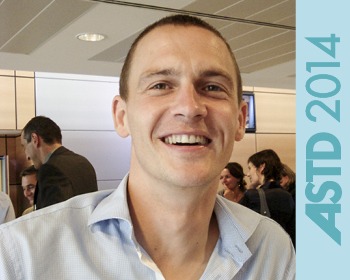David Rock of the NeuroLeadership Institute is here to tell us about the 2 most complicated things in the world: The Brain and Change. ASTD2014 session M202 is underway…
Understanding the brain makes better coaches
If a part of your job is to “make people better”, you are a “coach” says Rock. And although we’ve all been doing it for years and have some expertise, Rock says that unfortunately even if the coach thinks things went well, many coachees say that the coaching was not successful (only about 1 in 20 are, says Rock).
Rock starts with a story of his own experience with being coached, some 16 years ago. He noticed that when his coaches were asking questions, they were often doing it as some kind of “ego-full double-guessing” of the coachee. He had the feeling that although the coach was supposed to avoid giving input and solutions themselves (directive leadership), very often they would still somehow be leading people towards their own (coach) ideas and over-directing the conversation. Rock thinks it would be far more effective to really make the coachee think for themselves and help them to generate insight themselves. That’s what coaching is is for Rock: Facilitating positive change by improving thinking. The role of the coach is to help people to create new unconscious habits to achieve the things they want. And he adds that if you understand the brain, you can do that better.
Rock says that coaches who understand how the brain functions get better results. He says that objective measurements show this. If you look at the change in behaviour and it’s impact on results following the coaching initiative, you can see things are better with a brain-understanding coach, than one who does not have these insights.
OK David, I’m sold. Now tell me what I need to know!
4 steps to get people to a new (unconscious) habit
For people to create new habits, they need to take repetitive action over time. And to actually want to take that action, coachees need to have an insight moment or “ah-ha” moments. This creates better connections in the brain and motivates them for action. And to get that insight, they need to be in a “toward” state.
In general, says Rock, much of what happens in the brain at a neural level is about the brain’s perception of whether or not what is going on is good or bad. If it’s good, we want to move toward it and do more (create more neural connections). If it’s bad, we want to move away from it (the brain stops getting involved in things). Rock says quite simply that you cannot create “insight” if the person is in an “away” state.
To create the “toward state” we have to create positive SCARF.
Rock says that there are some simple things we can do to create a more positive SCARF:
- Tell people how long you are going to talk to increase certainty
- Ask a question before you say what you want to say creates more status, relatedness and a sense of fairness
- Avoid anything that might seem like an attack
- Focus first on creating more relatedness by spending time listening to the goals of the coachee
- Understand that different people might have different SCARF profiles (ie CEOs might be more interested in autonomy; project managers might focus more on certainty)
- Don’t use sentences like “tell me about the problem” – this puts people in an away state, because they are focussing on things they don’t like, or want to avoid
- Use thoughtful, inward-directed and neutral questions
- Pay attention to people around you. If you understand SCARF (see book link below), Rock says you will quickly spot who has a preference for what.
- Try to let coachees come to their own insights themselves. This will increase status, which will be more motivating.
What can we do to create more insights?
- Create some quiet time. Give time to the coachee. As a coach: Shut up!
- Allow the coachee to look inward. If your brain is being bombarded by light and sound and other stimuli, there are less chances of having insights.
- A slightly happy state is better than a slightly unhappy or anxious state.
- Not working directly on the problem creates more insights than directly trying to solve it.
Regarding the last point: When I hear David Rock saying this, I am thinking about my own coaching sessions and how I use the GROW model. Typically, we might discuss goals and reality before moving toward looking for opportunities to improve things. But Rock says that generally, real insights don’t come when we are trying to have them. They come later, when we are quiet or when we are feeling good (which is generally not when I’m being interrogated by a coach!).
Don’t focus on the problem, focus on how the coachee is thinking
The final lesson I took away from Rock’s session today is that coaches need to change the way they look at what is going on in their coaching sessions. Too often, even if we are not offering solutions (directive style) , we are still there with the coachee trying to solve the problem. We need to stop this. Let the coachee look at the problem we should be looking at the coachee and how he or she is thinking, “going toward” and discovering insights.
See also:
- For more information on SCARF, see David Rock’s PDF here.
- notes from Josh Davis’ session on how to make learning stick
- Read David Rock’s book “Your brain at work”
- Take the SCARF self-assessment here









